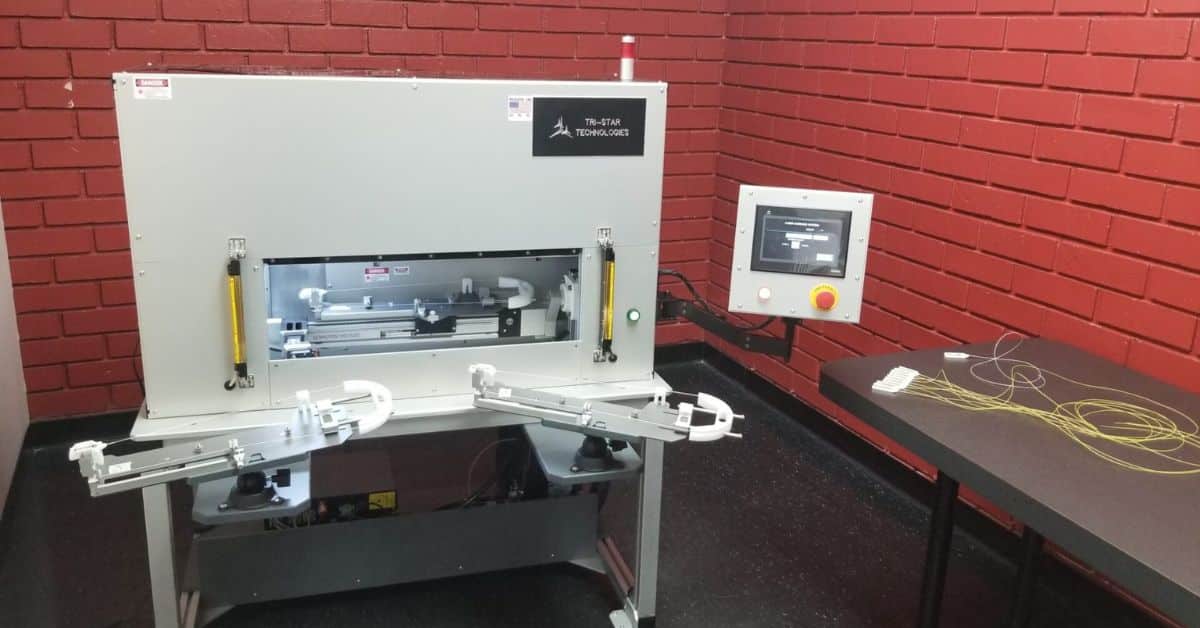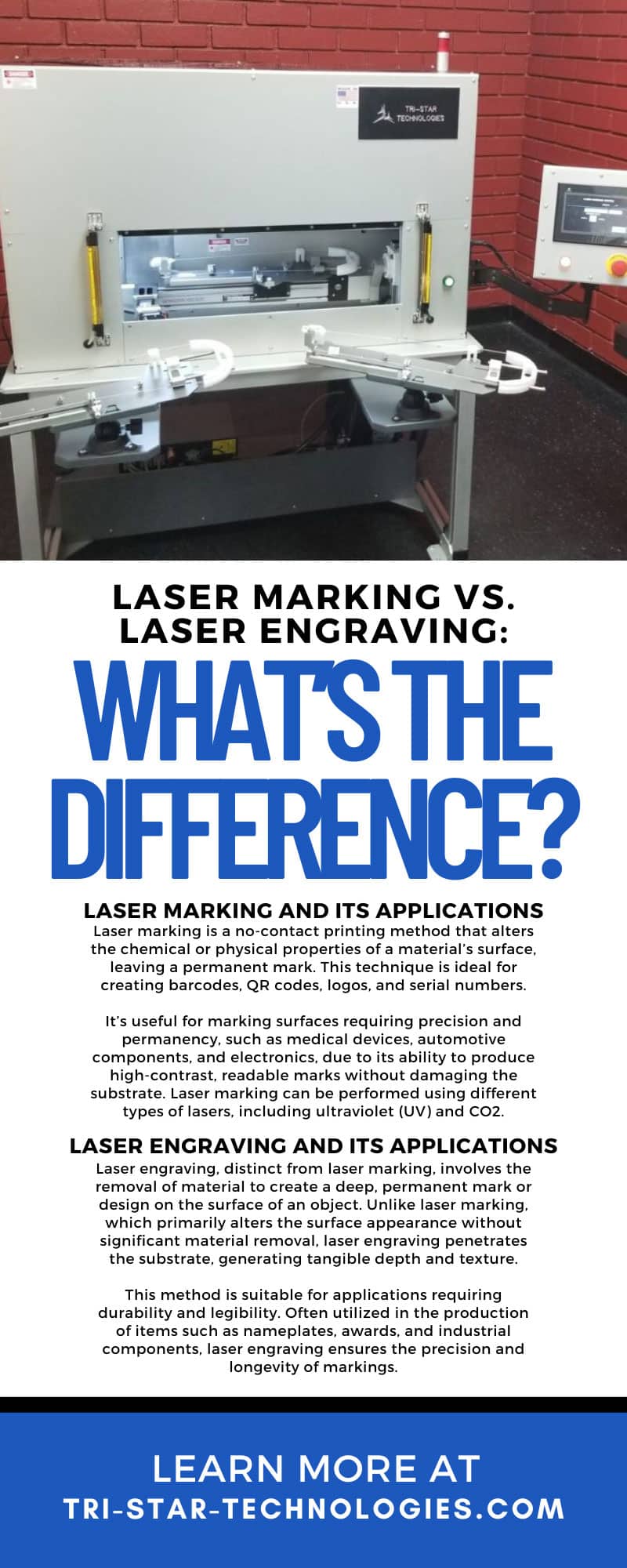Laser Marking vs. Laser Engraving: What’s the Difference?

Laser technology stands as a beacon of innovation, precision, and versatility in the realm of manufacturing and personalization. Its application spans a multitude of industries, from aerospace to consumer goods, offering unparalleled accuracy.
Among the various laser technologies, laser marking and laser engraving are two of the most common. We’ll explain the differences between laser marking and laser engraving in detail so you can better understand what each method offers.
Introduction to Laser Technology
Laser technology has revolutionized the way we alter materials, marking a significant advancement in manufacturing and design. By harnessing the power of highly focused light beams, manufacturers can achieve detailed markings with unparalleled precision on almost any material. This includes metals, plastics, glass, and wood, allowing for versatility across different industries.
The precision offered by laser tooling is not just about aesthetics; it also serves critical functions. For instance, it enables the creation of intricate designs and patterns, enhancing the visual appeal of products and making them stand out. Moreover, laser technology is instrumental in serialization, branding, and traceability.
Laser Marking and Its Applications
Laser marking is a no-contact printing method that alters the chemical or physical properties of a material’s surface, leaving a permanent mark. This technique is ideal for creating barcodes, QR codes, logos, and serial numbers.
It’s useful for marking surfaces requiring precision and permanency, such as medical devices, automotive components, and electronics, due to its ability to produce high-contrast, readable marks without damaging the substrate. Laser marking can be performed using different types of lasers, including ultraviolet (UV) and CO2.
UV Laser Marking
UV laser marking utilizes short-wavelength light to produce high-resolution, precise markings on a variety of materials. Due to ultraviolet light’s short wavelength, UV lasers have a small focal spot size, enabling them to create fine details and high-contrast marks, even at low power levels.
They are ideal for marking delicate electronic components and medical devices. Additionally, UV laser marking is the only approved method of laser marking that meets aerospace and defense military specifications. Furthermore, UV laser marking offers excellent resistance to fading and corrosion, making it a popular choice for high-end consumer goods.
CO2 Laser Marking
CO2 laser marking employs a carbon dioxide gas mixture as the medium, which produces infrared light. This method is particularly effective for marking non-metallic materials, such as wood, glass, ceramics, paper, plastics, and metals with special coatings. The long wavelength of the CO2 laser allows it to heat the surface of the material, creating clear, indelible marks through processes like ablation, thermal bonding, and photochemical reactions.
Laser Engraving and Its Applications
Laser engraving, distinct from laser marking, involves the removal of material to create a deep, permanent mark or design on the surface of an object. Unlike laser marking, which primarily alters the surface appearance without significant material removal, laser engraving penetrates the substrate, generating tangible depth and texture.
This method is suitable for applications requiring durability and legibility. Often utilized in the production of items such as nameplates, awards, and industrial components, laser engraving ensures the precision and longevity of markings.
Comparing Laser Marking and Laser Engraving
When contrasting laser marking and laser engraving, several factors underscore the superiority of laser marking for a variety of applications.
Precision and Detail
Laser marking excels in terms of precision and detail. The process leverages highly focused beams to alter the surface properties of the material without removing any material. This allows for the production of intricate and high-contrast markings, such as barcodes, QR codes, and serial numbers, which are essential for industries requiring impeccable detail and readability. UV laser marking achieves finer details at lower power levels, making it ideal for delicate components and high-end consumer products.
Speed and Efficiency
In comparison to laser engraving, laser marking is quicker; operators are capable of producing numerous precise marks in a shorter amount of time. This makes it suitable for high-volume production environments, where speed and efficiency are critical.
CO2 laser marking systems, for example, offer the ability to mark organic materials quickly and consistently. The non-contact nature of laser marking also minimizes downtime associated with tool wear and maintenance, further enhancing operational efficiency.
Material Impact and Durability
One of the advantages of laser marking is its non-destructive nature. Unlike laser engraving, which physically removes material to create designs, laser marking modifies the surface characteristics without compromising the material’s integrity.
This is particularly beneficial for applications in the aerospace, medical, automotive, and electronics industries, where maintaining the material’s structural and functional properties is crucial for product development. Additionally, laser markings are resistant to wear, fading, and corrosion, ensuring long-lasting legibility.
Versatility and Application Diversity
Laser marking’s versatility in terms of applicable materials and methods positions it as the superior choice in many scenarios. It can be effective on metals, plastics, ceramics, glass, and more, providing consistent quality across diverse materials. Moreover, the adaptability of different industrial laser marking machines allows manufacturers to cater to unique project requirements without compromising quality or performance.
Factors for Choosing Between the Two Technologies
When deciding between laser marking and engraving, consider their differences, the material you’re working with, and the desired outcome of your project. Laser marking is the optimal choice for high-volume operations that demand quick turnaround times. It’s especially beneficial in situations where maintaining the integrity of the material is paramount. Laser marking leaves the surface largely untouched, altering only the color of the material for visibility.
Another factor to consider when choosing between laser marking and engraving is the material you’re working with. Laser marking is useful for a wide range of materials, including metals, plastics, glass, wood, and more. Engraving, on the other hand, is typically limited to harder materials such as metal and stone.
Ultimately, manufacturers and other users should base their decisions on a thorough analysis of the project’s requirements, materials, and the long-term durability of the ideal marking.
Consider Tri-Star Technologies for Your Laser Marking Needs
Understanding the nuances of laser marking and engraving is vital for manufacturers. By choosing the appropriate technology, you can ensure the aesthetic quality of the final product, compliance with industry standards, and longevity in the field. Equipping yourself with this knowledge can significantly enhance the value and functionality of manufactured goods and personal projects.
At Tri-Star Technologies, we pride ourselves on offering state-of-the-art laser marking solutions that meet the diverse needs of modern manufacturing and creative endeavors. Our cutting-edge equipment, combined with our industry expertise, empowers businesses and individuals to achieve their goals with precision and efficiency. Browse our technology online, or contact our staff to speak with our expert team about which laser marking solution is ideal for you.



